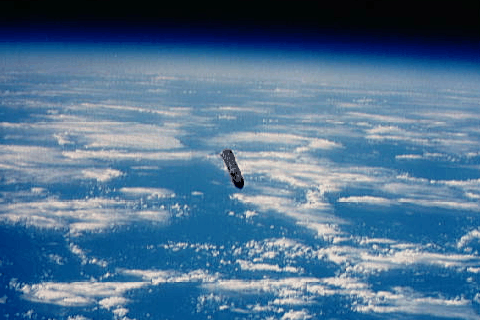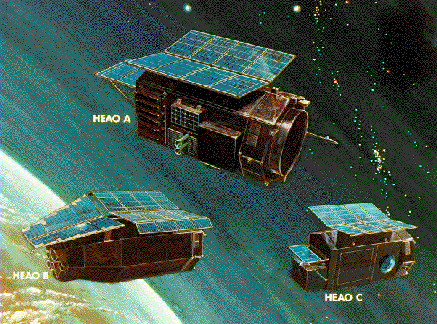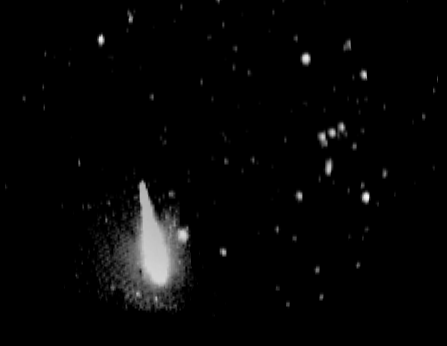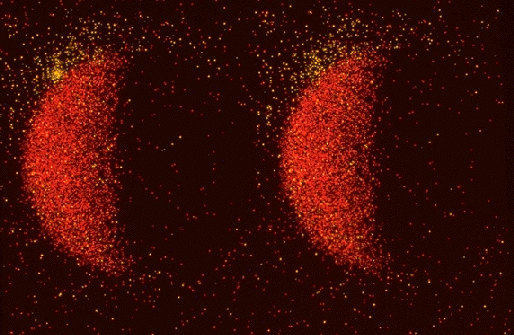#250 Tomorrow's picture: February 24, 1996

“Sixteen minutes after the liftoff of STS-29, the Space Shuttle Discovery's jettisoned External Tank (ET) is seen here, in a photograph by shuttle astronaut James P. Bagian, falling back towards Earth. The 154 foot long ET is the largest non-reusable component in the Shuttle system. After carrying over 500,000 gallons of liquid propellant to feed the shuttle's main engines during liftoff, its ultimate fate is to re-enter the atmosphere, break up and descend into a remote ocean area. The side of this ET shows a normal burn scar caused during the separation of one of the reusable solid rocket boosters."
Copyright: Public domain
#251 Tomorrow's picture: February 25, 1996

“Looking like a fleet of futuristic starcruisers poised over planet Earth, NASA's highly successful series of High Energy Astrophysical Observatory (HEAO) spacecraft appear above in a vintage illustration. Labeled A, B, and C in this conceptual picture, the spacebased telescopes were known as HEAO-1, HEAO-2, and HEAO-3 respectively. HEAO-1 and HEAO-2 were responsible for revealing to earthlings the wonders of the x-ray sky, discovering 1,000s of celestial sources of high-energy radiation. HEAO-2, also known as the Einstein Observatory, was launched near the date of the famous physicist's 100th birthday (November of 1978) and was the first large, fully imaging x-ray telescope in space. HEAO-3, the last in the series, was launched in 1979 and measured high energy cosmic-ray particles and gamma-rays."
Copyright: Public domain
#252 Tomorrow's picture: February 26, 1996

“On rare but spectacular occasions, fireballs, meteors brighter than the brightest stars, flash through the heavens - sometimes making audible sounds and occasionally surviving to strike the Earth's surface. The path of one such fireball, recorded last year in January skies over Hannover Germany is shown above, the brilliant meteor easily outshining the stars of the constellation Orion (visible at the far right). In fact, for this brief moment Sirius, the brightest star in the night sky, is overwhelmed as the image of the fireball grazes it. This dramatic event was recorded by a video camera observation technique known as MOVIE. Interplanetary space is littered with meteoroids, "rocks" tens of yards in diameter and less. Striking the Earth's atmosphere at high relative speeds, they leave visible trails known as meteors or, more poetically, "shooting stars". The trails are created when the intense heat caused by friction vaporizes them. Fireballs can be caused by meteroids weighing small fractions of an ounce which do not survive to reach the ground. Remnants of larger ones, which do reach the ground after running this fiery gauntlet, are called meteorites. Though fireballs are rare, meteors are visible on any clear night of the year. Even outside the predicted regular meteor shower events, patient observers in dark sky areas can see several an hour - by just looking up! Sightings of fireballs should be reported."
Copyright: Public domain
#253 Tomorrow's picture: February 27, 1996

“An X-ray star winks out behind the Moon in these before and after views of a lunar occultation of the galactic X-ray source designated GX5-1. The false color images were made using data from the ROSAT orbiting observatory and show high energy X-rays in yellow (mostly from GX5-1), and lower energy X-rays in red (the Moon reflecting X-rays from the Sun). GX5-1 is a binary system consisting of a neutron star and a companion star in mutual orbit about the system's center of mass. The gas in the companion star's outer envelope falls toward the neutron star and accumulates in a disk around it. This disk material swirls deeper in to the neutron star's gravitational well, and is finally dumped onto its surface - in the process creating tremendous temperatures and generating the high energy X-rays."
Copyright: Public domain
#254 Tomorrow's picture: February 28, 1996

“Tremendous explosions near the center of our Galaxy were discovered just this past December and are being announced today by a paper in Nature and a press conference at NASA. Bursts like these have never been seen before, and so the exact cause is unknown and will likely be the source of astronomical speculations and observations for years to come. Much more powerful than any explosions we humans can create, these eruptions likely involve the extreme conditions found only on the surface of a neutron star in a binary system, possibly similar to the X-ray binary system depicted in the above drawing. The new source, dubbed GRO J1744-28 for its discovery spacecraft and position, currently produces multiple pulsed bursts of energy per day, each of which last several seconds. The bursts are quite prominent in X-ray light. Discovery team leaders include Chryssa Kouveliotou (USRA) and Gerald Fishman (NASA /MSFC)."
Copyright: Public domain
#255 Tomorrow's picture: February 29, 1996

“Today, February 29th, is a leap day - a relatively rare occurrence. Advised by Alexandrian astronomer Sosigenes, Roman dictator Julius Caesar, pictured above in a self-decreed minted coin, created a calender system in 46 BC that contained one leap day every four years. The reason for adding leap days was that a year - defined by the time it takes the Earth to circle the Sun - does not actually take an exact integer number of days - defined by the time it takes for the Earth to rotate once. In fact, one year by these astronomical definitions is about 365.24219 days. If all calendar years contained 365 days, they would drift from the actual year by about 1 day every 4 years. Eventually July (named posthumously for Julius Caesar himself) would occur during the northern hemisphere winter! By making most years 365 days but every fourth year 366 days, the calendar year and the actual year remained more nearly in step. This "Julian" calender system was used until the year 1582 when Pope Gregory XIII added that leap days should not occur in years ending in "00" except if divisible by 400, providing a further fine tuning. This "Gregorian" calender system is the one in most common use today."
Copyright: Public domain
#256 Information: March 01, 1996

“Sometimes the simplest shapes are the hardest to explain. For example, the origin of the mysterious cone-shaped region located just below the center of the above picture remains a mystery. The dark region clearly contains much dust which blocks light from the emission nebula and open cluster NGC 2264 behind it. One hypothesis holds that the cone is formed by wind particles from an energetic source blowing past the Bok globule at the head of the cone. Information: The Scale of the Universe Debate in April 1996"
Copyright: Anglo-Australian Telescope
Board
#257 Information: March 02, 1996

“Orbiting 1,075 miles above the Earth, a 250 foot wide, inflated, reinforced nylon "wheel" was conceived in the early 1950s to function as a navigational aid, meteorological station, military platform, and way station for space exploration by rocket pioneer Wernher von Braun. The wheel shaped station could be easily rotated creating artificial gravity so that the astronauts would not suffer the effects of prolonged weightlessness. Von Braun and his team favored building a permanently occupied Earth orbiting space station from which to stage a lunar exploration program. But in the 1960s NASA adopted the Apollo Program, which called for astronauts to transfer to a lunar landing vehicle after achieving lunar orbit, bypassing the construction of von Braun's wheel. Information: The Scale of the Universe Debate in April 1996"
Copyright: Public domain
#258 Information: March 03, 1996

“What formed Ariel's valleys? This question presented itself when Voyager 2 passed this satellite of Uranus in January 1986. Speculation includes that heating caused by the ancient tides of Uranus caused moonquakes and massive shifting of the moon's surface. In any event, a huge network of sunken valleys was found to cover this frozen moon, and some unknown material now coats the bottoms of many of these channels. Ariel is the second closest to Uranus outside of Miranda, and is composed of roughly half water ice and half rock. Ariel was discovered by William Lassell in 1851. Information: The Scale of the Universe Debate in April 1996"
Copyright: Public domain
Upvote! Resteem! Comment! As you like it! Thank you for attention!
Why no one except robots leaves here a replyes???
Hi! I am a robot. I just upvoted you! I found similar content that readers might be interested in:
https://apod.nasa.gov/apod/ap960226.html